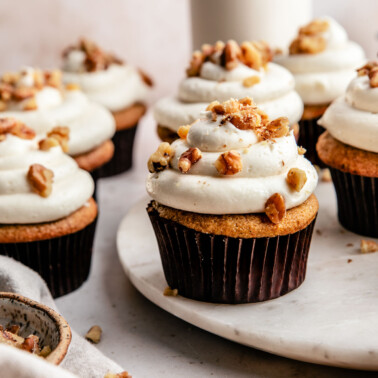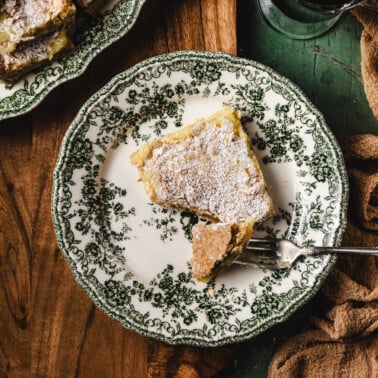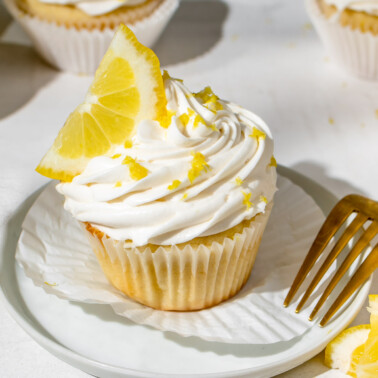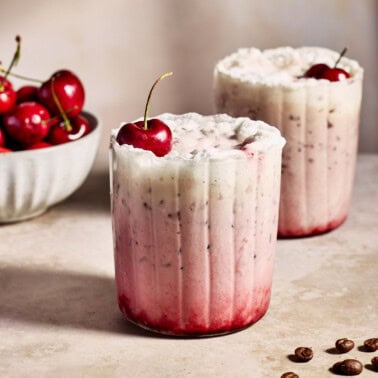Gluten-Free Birthday Cake Recipe (Funfetti!)
Published Apr 18, 2024
This post may contain affiliate links. Please read our disclosure policy.
A classic gluten-free moist vanilla cake with layers of vanilla buttercream icing and rainbow sprinkles throughout, this Gluten-Free Birthday Cake is the ultimate celebration treat! Makes 6, or 8-inch cakes and includes tips, tricks, and troubleshooting so you get the best confetti cake, every time!

What Makes This Recipe Great
For my daughter’s birthday celebration, she requested that I make her cake, and I was smitten by her request. Making my girls’ cakes is truly one of the greatest joys, and as they get older I am so thrilled they still want me to make them! She wanted a simple, classic birthday cake, with a few adjustments that fit our lives best.
So without further ado, let me introduce you to the BEST gluten-free birthday cake you will ever make! I am blown away by this delicious cake. It’s moist, tender, and absolutely perfect in every way. Plus, it’s pretty darn simple, which highlights that it truly is the little things in life.
This gluten-free funfetti cake recipe is made up of vanilla cake layers topped with my homemade buttercream frosting and covered in rainbow sprinkles. It’s cute and festive, and do you remember me telling you how delicious it is?! The perfect birthday cake!
I’ve included many tips and tricks in this recipe because I know gluten-free baking can be tricky sometimes. I’ve tested and re-tested to make sure this is perfect for y’all and my sweet baby girl! Whether it’s your first time or your millionth time baking, I hope this cake makes your special occasion wonderful and tasty! Happy baking!
If you’re looking for a vegan white cake, try my Vegan Vanilla Cake with Buttercream Recipe.
Ingredient Notes

- Gluten-free flour blend: I use King Arthur’s Measure for Measure. These blends contain xanthan gum which helps with the texture and structure of the cake since there is no gluten in the flour. Bob’s Red Mill is another great option. I do not recommend almond flour or another alternative. Please use a 1:1 gluten-free all-purpose flour blend.
- Sugar
- Butter
- Whole eggs
- Egg whites
- Whole milk
- Buttermilk
- Sour cream
- Gluten-free baking powder
- Pure vanilla extract
- Rainbow sprinkles: For inside the batter and to decorate the cake.
- Vanilla frosting: You can use a storebought favorite or try my homemade buttercream frosting recipe. All you need are 5 ingredients: butter, shortening, powdered sugar, vanilla extract, and milk. My vegan buttercream uses dairy-free alternatives like vegan butter.
Step-by-Step Instructions

- Preheat the Oven: Preheat your oven to 350°F (175°C). Prepare (2) 8-inch or (3) 6-inch round cake pans by greasing them and lining the bottoms with parchment paper. Set aside.
- Sift the Dry Mix: In a large bowl, sift together the gluten-free flour and baking powder. Set aside
- Cream Butter & Sugar: In a large mixing bowl, cream together the softened butter and sugar for 3-5 minutes until light and fluffy using a hand mixer or stand mixer. Creaming the butter and sugar is a crucial step in getting the perfect texture. Add the eggs and egg whites one at a time, beating well after each addition. Stir in the vanilla extract.
- Mix the Milk and Sour Cream: In another bowl, combine the whole milk, buttermilk, and sour cream.
- Prepare the Batter: Add the dry ingredients to the butter mixture in three additions, alternating with the wet ingredients, starting and ending with the dry ingredients. Mix until just combined, being careful not to overmix. Gently fold in the colorful sprinkles until evenly distributed throughout the cake batter.
- Add Batter To Pans: Divide the batter evenly among the prepared cake pans. Smooth the tops with a spatula to even out the batter.
- Filling Cake Pans Correctly: For an 8 or 9-inch round cake pan, you typically want to fill it no more than two-thirds to three-quarters full, depending on the recipe. When filling a 6-inch cake pan with batter, you typically want to fill it to about halfway.
- Bake: Place the pans in the preheated oven and bake for 35-40 minutes, or until a toothpick inserted into the center of the cakes comes out clean.
- Cool: Remove the cakes from the oven and let them cool in the pans for 10 minutes. After 10 minutes, carefully remove the cakes from the pans and transfer them to a wire rack to cool completely.
- Optional Step: Freeze the cake for easier decorating! You can skip right ahead to step 11, but if you want to use my trick for better taste and easier decorating, wrap your cooled cakes in plastic wrap and freeze for 6-24 hours. Once frozen, move on to the assembly. Then, cover your frosted cake and let it thaw at room temperature for 2-4 hours before serving. Don’t refrigerate or it can dry out.
- Assemble the Cake: Once the cakes are completely cooled, you can assemble the cake by layering them with your favorite frosting between each layer. Optionally, you can frost the top of the cake and the sides of the cake with more frosting.
- Sprinkle by Hand: Place the cake over a baking sheet or large plate to catch any excess sprinkles. With clean hands, gently press the sprinkles onto the sides of the cake, rotating the cake as you go to ensure even coverage.

Mac’s Pro Tip
Expert Tips
- Room Temperature Ingredients: Make sure your butter, eggs, and any dairy products are at room temperature before you begin baking. Room-temperature ingredients mix more easily and evenly, resulting in a smoother batter and better texture.
- Properly Measure Ingredients: Use a kitchen scale for precise measurements, especially when it comes to flour and sugar. If you don’t have a scale, use the spoon-and-level method for dry ingredients to avoid packing them down.
- Preheat the Oven: Always preheat your oven before baking. This ensures that your cake will start cooking at the correct temperature, which is essential for even baking and rising.
- Prepare Your Pans: Properly prepare your cake pans by greasing and flouring them or lining them with parchment paper. This prevents the cake from sticking to the pan and ensures easy removal.
- Evenly Distribute Batter: When dividing the batter between cake pans, use a kitchen scale to ensure they all have the same amount. This helps the cakes bake evenly and ensures they’re all the same size.
- Rotate Pans: If your oven has hot spots (which many do), rotate the cake pans halfway through baking to ensure even cooking.
- Test for Doneness: Use a toothpick or cake tester to check if the cake is done. Insert it into the center of the cake; if it comes out clean or with a few crumbs clinging to it, the cake is done.
- Cool Properly: Allow the cake to cool in the pan for 10-15 minutes before transferring it to a wire cooling rack to cool completely. Cooling too quickly can cause the cake to collapse while cooling too slowly can lead to a soggy bottom.
- Frost with Care: Make sure the cake is completely cooled before frosting it. If the cake is warm, the frosting will melt and slide off. Crumb coat the cake first to trap any loose crumbs, then apply a final layer of frosting for a smooth finish.
Frosting Tips
I place my cakes in the freezer for 6-24 hours before frosting them for best results, fewer crumbs, and easier decorating!
Reasons to Freeze
- Easier Assembly: Some cakes, especially layered or decorated cakes, can be easier to assemble and frost when the layers are frozen. Frozen cakes are firmer and less prone to crumbling, making them easier to handle.
- Flavor Enhancement: Some cakes actually taste better after being frozen and thawed. Freezing can help the flavors meld together, resulting in a more moist and flavorful cake.
How to Avoid “Cake Sink”
- Use the Right Amount of Batter: Overfilling the cake pan can lead to overflow and sinking. Use the appropriate amount of batter for your cake pan size. For an 8-inch round cake pan, you typically want to fill it no more than two-thirds to three-quarters full, depending on the recipe.
- Level the Batter: After pouring the batter into the cake pan, use a spatula or the back of a spoon to gently spread and level the batter evenly in the pan. Make sure it reaches the edges and corners uniformly.
- Tap Out Air Bubbles: Tap the filled cake pan gently against the countertop a few times to release any air bubbles trapped in the batter. Air bubbles can cause uneven rising and contribute to sinking in the center of the cake.
- Proper Oven Temperature: Preheat your oven to the correct temperature before baking the cake. Baking at too low a temperature can cause the cake to sink while baking at too high a temperature can lead to uneven rising and cracking.
- Avoid Opening the Oven Door: While the cake is baking, resist the temptation to open the oven door frequently, as this can cause fluctuations in temperature and disrupt the baking process, leading to sinking.
- Test for Doneness: Use a toothpick or cake tester inserted into the center of the gluten-free birthday cake to check for doneness. If it comes out clean or with a few crumbs clinging to it, the cake is done. Avoid opening the oven door too early in the baking process to prevent sinking.
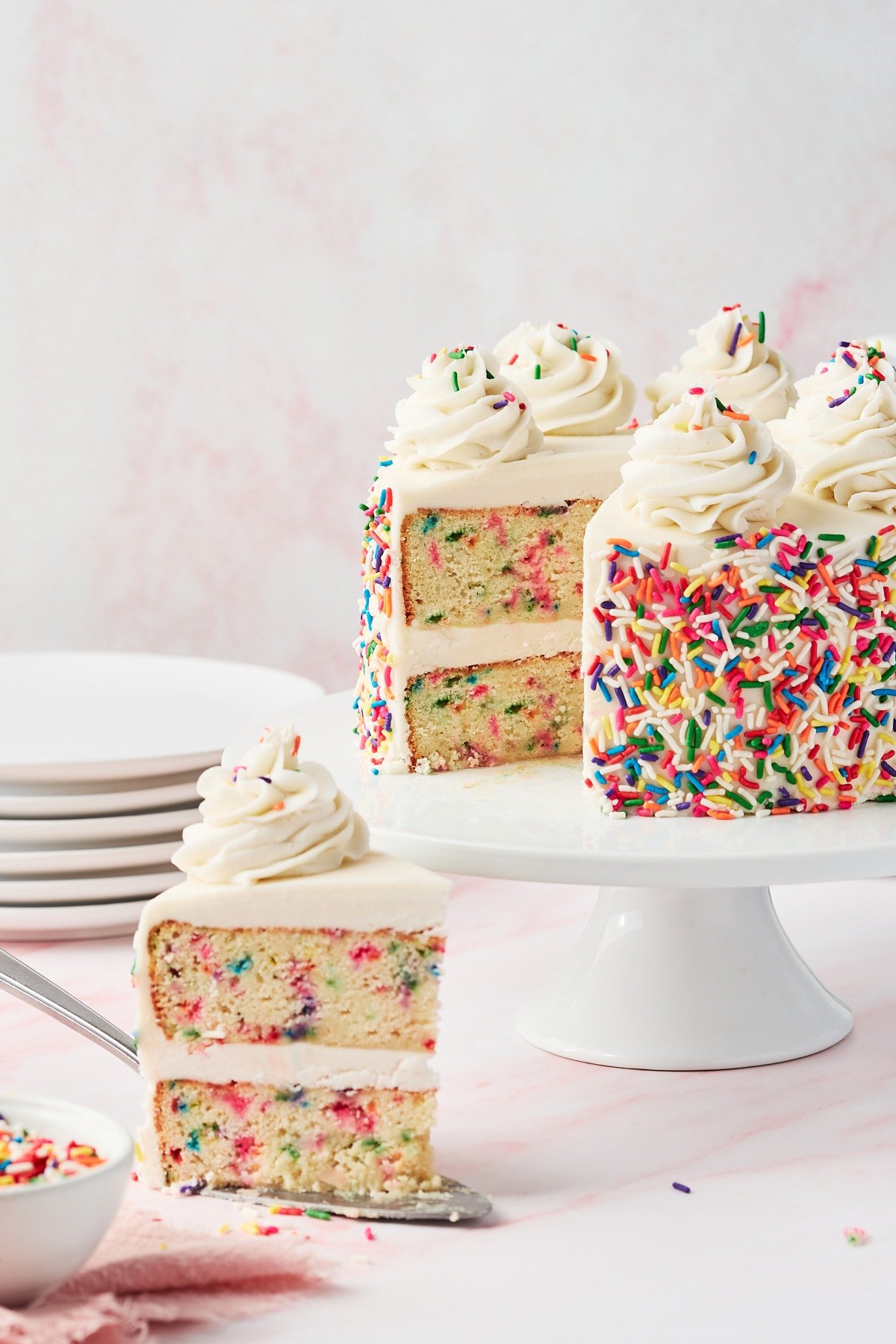
Storage Tips
Once you’ve frosted a frozen cake, you’ll want to store it properly to maintain its freshness and appearance. Here’s how to do it:
- Room Temperature: Keep it in a cool, dry place away from direct sunlight. A cake dome or an overturned bowl can help protect the cake from dust and debris.
- Avoid Moisture: Whether stored in the refrigerator or at room temperature, it’s essential to protect the cake from moisture. Condensation can form on the surface of the cake when it’s moved from the cold to a warmer environment, which can cause the frosting to become wet and sticky. To prevent this, allow the cake to come to room temperature slowly by leaving it uncovered for a short time before serving.
- Storing: In general, buttercream cakes can be stored at room temperature for up to three days as long as they are properly covered using an airtight container. This will prevent the gluten-free birthday cake from drying out. It is OK to store a buttercream cake in the fridge if the kitchen is going to be too hot or humid.
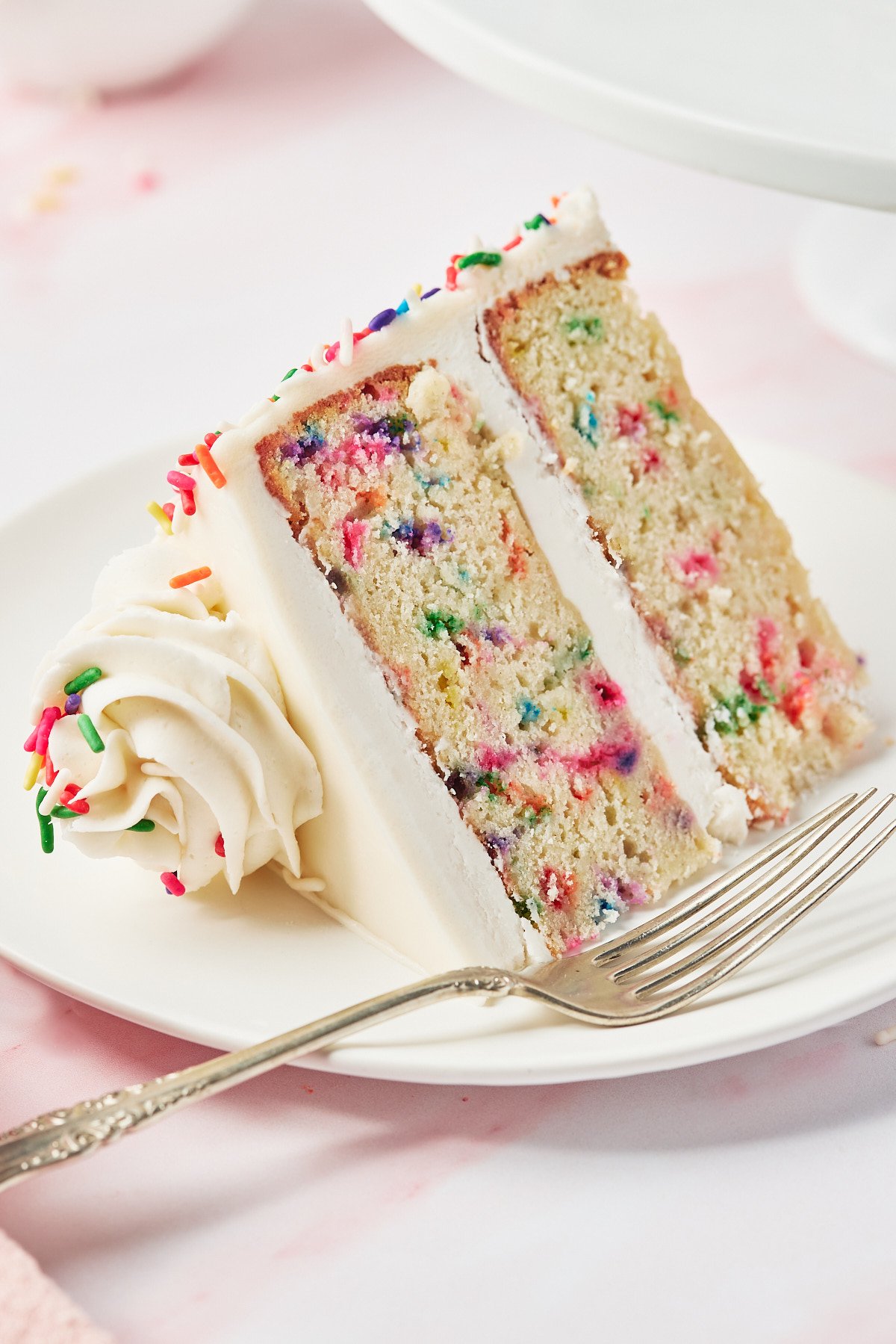
Recipe FAQs
Yes! This gluten-free birthday cake recipe will make 24-28 cupcakes.
I always test and recommend all-in-one blends that are a 1:1 swap with all-purpose flour. My favorite brands is King Arthur Gluten-Free Measure for Measure and Bob Red’s Mill Gluten-Free1:1 Baking Flour. I also like Cup4Cup Gluten-Free Flour.
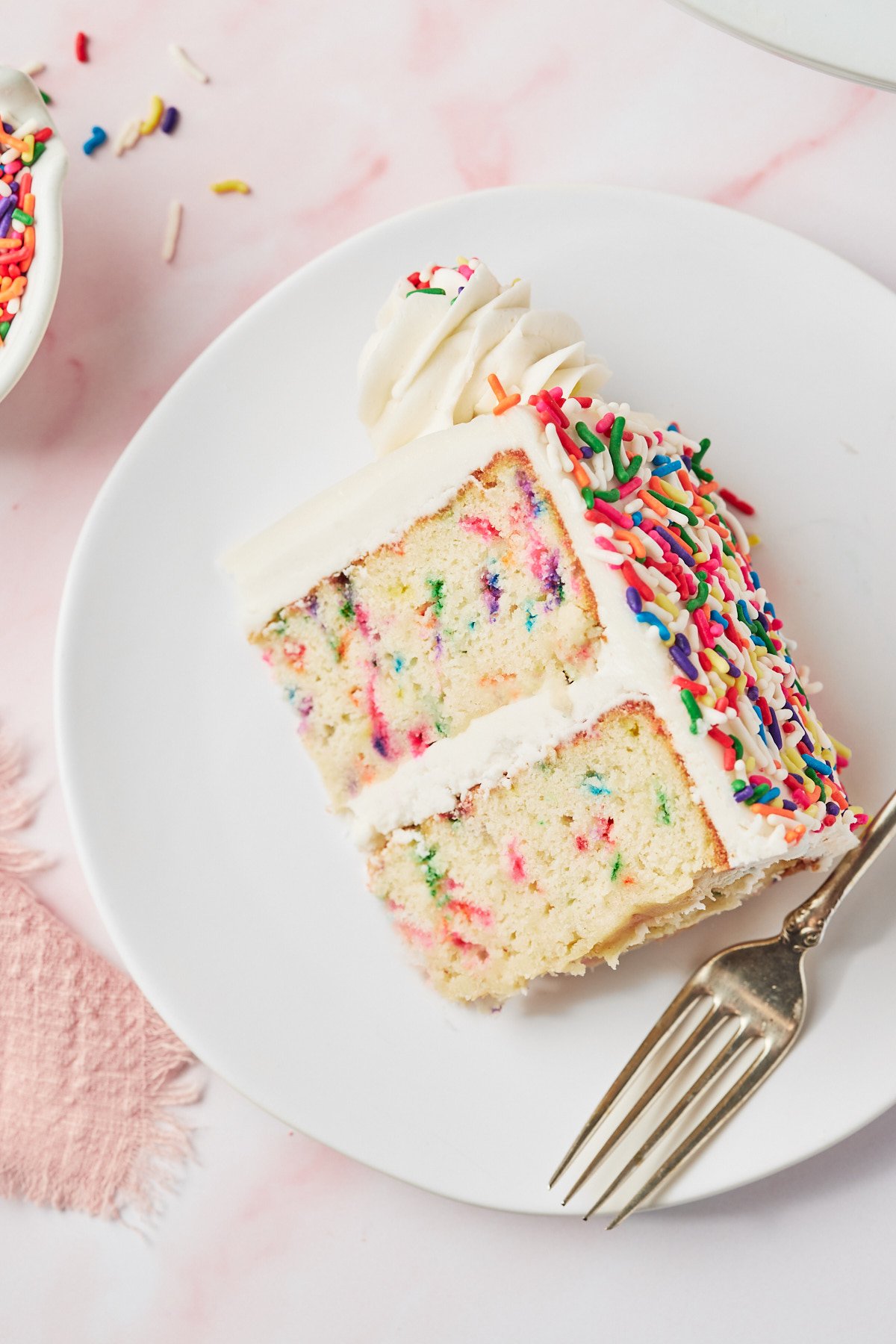
More Gluten-Free Cake Recipes
Follow on Instagram
Follow on Instagram
If you love this recipe, please give it a star rating and leave a comment below! Follow me on Pinterest, Facebook, and Instagram for more!


Gluten-Free Birthday Cake Recipe (Funfetti!)
Ingredients
- 3 cups gluten-free flour (360g) I use King Arthur's Measure for Measure
- 2 cups sugar (400g)
- 2 sticks butter (1 cup 227g)
- 4 large eggs
- 2 large egg whites
- 3/4 cup whole milk
- 1/4 cup buttermilk
- 1/3 cup sour cream
- 1 tbsp + 2 tsp gluten-free baking powder
- 3 tsp vanilla extract
- 3/4-1 cup sprinkles
Buttercream Frosting
- 1 cup unsalted butter 2 sticks
- 1/3 cup heavy whipping cream
- 4.5-5 cups confectioners sugar sifted
- 2 tsp clear vanilla extract
Instructions
Gluten-Free Cake
- Preheat the Oven:Preheat your oven to 350°F (175°C). Prepare (2) 8-inch or (3) 6-inch round cake pans by greasing them and lining the bottoms with parchment paper. Set aside.
- Sift the Dry Mix: In a separate bowl, sift together the gluten-free flour and baking powder. Set aside
- Cream Butter & Sugar: In a large mixing bowl, cream together the softened butter and sugar 3-5 minutes until light and fluffy using a hand mixer or stand mixer. Creaming the butter and sugar is a crucial step in getting the perfect texture. Add the eggs and egg whites one at a time, beating well after each addition. Stir in the vanilla extract.
- Mix the Milk and Sour Cream: In another bowl, combine the whole milk, buttermilk, and sour cream.
- Prepare the Batter: Add the dry ingredients to the butter mixture in three additions, alternating with the wet ingredients, starting and ending with the dry ingredients. Mix until just combined, being careful not to overmix. Gently fold in the sprinkles until evenly distributed throughout the batter.
- Add Batter To Pans: Divide the batter evenly among the prepared cake pans. Smooth the tops with a spatula to even out the batter.
- Filling Cake Pans Correctly: For an 8 or-9 inch round cake pan, you typically want to fill it no more than two-thirds to three-quarters full, depending on the recipe. When filling a 6-inch cake pan with batter, you typically want to fill it to about halfway
- Bake: Place the pans in the preheated oven and bake for 35-40 minutes, or until a toothpick inserted into the center of the cakes comes out clean.
- Cool: Remove the cakes from the oven and let them cool in the pans for 10 minutes. After 10 minutes, carefully remove the cakes from the pans and transfer them to wire racks to cool completely.
- Optional Step: Freeze the cake for easier decorating! You can skip right ahead to step 11, but if you want to use my trick for better taste and easier decorating, wrap your cooled cakes in plastic wrap and freeze for 6-24 hours. Once frozen, move on to the assembly. Then, cover your frosted cake and let it thaw at room temperature for 2-4 hours before serving. Don’t refrigerate or it can dry out.
- Assemble the Cake: Once the cakes are completely cooled, you can assemble the cake by layering them with your favorite frosting between each layer. Optionally, you can frost the top and sides of the cake with more frosting.
- Sprinkle by Hand: Place the cake over a baking sheet or large plate to catch any excess sprinkles. With clean hands, gently press the sprinkles onto the sides of the cake, rotating the cake as you go to ensure even coverage.
Buttercream Icing
- In a stand mixer, add the butter and beat together with the paddle attachment or use a hand mixer on medium speed until smooth and creamy. Add the vanilla extract to the butter and continue to beat until well combined.
- Gradually add the confectioners’ sugar to the butter, one cup at a time. Start the mixer on low speed to avoid a sugar shower. Scrape down the sides of the bowl as needed. Add the heavy cream slowly. Check the consistency of the buttercream. If it’s too thick, add a little more heavy cream, one tablespoon at a time, until you reach your desired consistency. If it’s too thin, add a bit more confectioners’ sugar. TIP: If you want bright white icing, add a very small touch of purple food coloring. This cancels out the yellow tint and makes it super white. If you want enough icing to decorate the top, I recommend doubling the buttercream recipe.
Notes
Expert Tips
-
- Room Temperature Ingredients: Make sure your butter, eggs, and any dairy products are at room temperature before you begin baking. Room-temperature ingredients mix more easily and evenly, resulting in a smoother batter and better texture.
-
- Properly Measure Ingredients: Use a kitchen scale for precise measurements, especially when it comes to flour and sugar. If you don’t have a scale, use the spoon-and-level method for dry ingredients to avoid packing them down.
-
- Preheat the Oven: Always preheat your oven before baking. This ensures that your cake will start cooking at the correct temperature, which is essential for even baking and rising.
-
- Prepare Your Pans: Properly prepare your cake pans by greasing and flouring them or lining them with parchment paper. This prevents the cake from sticking to the pan and ensures easy removal.
-
- Evenly Distribute Batter: When dividing the batter between cake pans, use a kitchen scale to ensure they all have the same amount. This helps the cakes bake evenly and ensures they’re all the same size.
-
- Rotate Pans: If your oven has hot spots (which many do), rotate the cake pans halfway through baking to ensure even cooking.
-
- Test for Doneness: Use a toothpick or cake tester to check if the cake is done. Insert it into the center of the cake; if it comes out clean or with a few crumbs clinging to it, the cake is done.
-
- Cool Properly: Allow the cake to cool in the pan for 10-15 minutes before transferring it to a wire cooling rack to cool completely. Cooling too quickly can cause the cake to collapse while cooling too slowly can lead to a soggy bottom.
-
- Frost with Care: Make sure the cake is completely cooled before frosting it. If the cake is warm, the frosting will melt and slide off. Crumb coat the cake first to trap any loose crumbs, then apply a final layer of frosting for a smooth finish.
Frosting Tips
I place my cakes in the freezer for 6-24 hours before frosting them for best results, fewer crumbs, and easier decorating!Reasons to Freeze
-
- Easier Assembly: Some cakes, especially layered or decorated cakes, can be easier to assemble and frost when the layers are frozen. Frozen cakes are firmer and less prone to crumbling, making them easier to handle.
-
- Flavor Enhancement: Some cakes actually taste better after being frozen and thawed. Freezing can help the flavors meld together, resulting in a more moist and flavorful cake.
How to Avoid “Cake Sink”
-
- Use the Right Amount of Batter: Overfilling the cake pan can lead to overflow and sinking. Use the appropriate amount of batter for your cake pan size. For an 8-inch round cake pan, you typically want to fill it no more than two-thirds to three-quarters full, depending on the recipe.
-
- Level the Batter: After pouring the batter into the cake pan, use a spatula or the back of a spoon to gently spread and level the batter evenly in the pan. Make sure it reaches the edges and corners uniformly.
-
- Tap Out Air Bubbles: Tap the filled cake pan gently against the countertop a few times to release any air bubbles trapped in the batter. Air bubbles can cause uneven rising and contribute to sinking in the center of the cake.
-
- Proper Oven Temperature: Preheat your oven to the correct temperature before baking the cake. Baking at too low a temperature can cause the cake to sink while baking at too high a temperature can lead to uneven rising and cracking.
-
- Avoid Opening the Oven Door: While the cake is baking, resist the temptation to open the oven door frequently, as this can cause fluctuations in temperature and disrupt the baking process, leading to sinking.
-
- Test for Doneness: Use a toothpick or cake tester inserted into the center of the cake to check for doneness. If it comes out clean or with a few crumbs clinging to it, the cake is done. Avoid opening the oven door too early in the baking process to prevent sinking.
Storage Tips
Once you’ve frosted a frozen cake, you’ll want to store it properly to maintain its freshness and appearance. Here’s how to store your Gluten-Free Birthday Cake:- Room Temperature: Keep it in a cool, dry place away from direct sunlight. A cake dome or an overturned bowl can help protect the cake from dust and debris.
- Avoid Moisture: Whether stored in the refrigerator or at room temperature, it’s essential to protect the cake from moisture. Condensation can form on the surface of the cake when it’s moved from the cold to a warmer environment, which can cause the frosting to become wet and sticky. To prevent this, allow the cake to come to room temperature slowly by leaving it uncovered for a short time before serving.
- Storing: In general, buttercream cakes can be stored at room temperature for up to three days as long as they are properly covered using an airtight container. This will prevent the funfetti cake from drying out. It is OK to store a buttercream cake in the fridge if the kitchen is going to be too hot or humid.
Equipment
Nutrition
Nutrition information is automatically calculated, so should only be used as an approximation.

